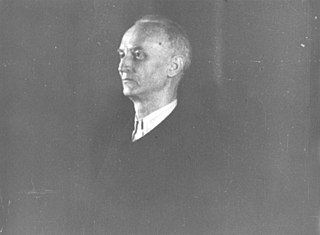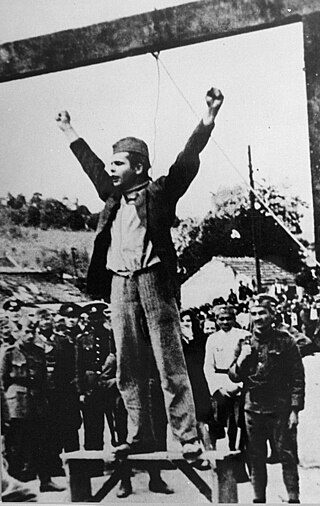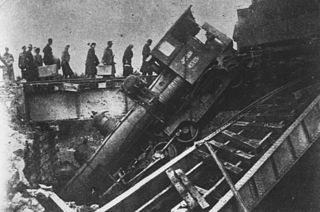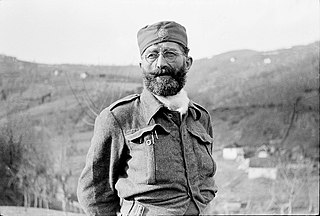
The Chetniks, formally the Chetnik Detachments of the Yugoslav Army, and also the Yugoslav Army in the Homeland and the Ravna Gora Movement, was a Yugoslav royalist and Serbian nationalist movement and guerrilla force in Axis-occupied Yugoslavia. Although it was not a homogeneous movement, it was led by Draža Mihailović. While it was anti-Axis in its long-term goals and engaged in marginal resistance activities for limited periods, it also engaged in tactical or selective collaboration with Axis forces for almost all of the war. The Chetnik movement adopted a policy of collaboration with regard to the Axis, and engaged in cooperation to one degree or another by both establishing a modus vivendi and operating as "legalised" auxiliary forces under Axis control. Over a period of time, and in different parts of the country, the movement was progressively drawn into collaboration agreements: first with the puppet Government of National Salvation in the German-occupied territory of Serbia, then with the Italians in occupied Dalmatia and Montenegro, with some of the Ustaše forces in northern Bosnia, and, after the Italian capitulation in September 1943, with the Germans directly.

Dragoljub "Draža" Mihailović was a Yugoslav Serb general during World War II. He was the leader of the Chetnik Detachments of the Yugoslav Army (Chetniks), a royalist and nationalist movement and guerrilla force established following the German invasion of Yugoslavia in 1941.

Serbian diaspora refers to Serbian emigrant communities in the diaspora. The existence of a numerous diaspora of Serbian nationals is mainly a consequence of either economic or political reasons.

Stevan Moljević was a Yugoslav and Serbian politician, lawyer and publicist, president of the Yugoslav-French Club, president of the Yugoslav-British Club, president of Rotary International Club of Yugoslavia and member of the Central National Committee of Yugoslavia (CNK) in World War II. In his 1941 memorandum Homogeneous Serbia, Moljević advocated the creation of the Greater Serbia and its ethnic cleansing of the non-Serb population.

Raška is a town and municipality located in the Raška District of southwestern Serbia. The municipality has a population of 24,680 people, while the town has a population of 6,574 people. It covers an area of 670 km2. The town is situated on the rivers Raška and Ibar.

Operation Uzice was the first major counter-insurgency operation by the German Wehrmacht on the occupied territory of the Kingdom of Yugoslavia during World War II. The operation was directed against the Užice Republic, the first of several "free territories" liberated by the Yugoslav Partisans. It was named after the town of Užice, and is associated with the First Enemy Offensive in Yugoslavian historiography. The security forces of the German-installed puppet regime of Milan Nedić also participated in the offensive.

Stjepan Filipović was a Yugoslav communist who led the Kolubara Company of the Valjevo Partisan Detachment during the 1941 Partisan uprising. He was captured and executed in 1942 in Valjevo. A photo of him taken shortly before his execution became a symbol of resistance against fascism in the Second World War, and was, among others, exhibited in the United Nations building in New York. He was proclaimed People's Hero of Yugoslavia in 1949.

The Socialist Republic of Montenegro, commonly referred to as Socialist Montenegro or simply Montenegro, was one of the six republics forming the Socialist Federal Republic of Yugoslavia and the nation state of the Montenegrins. It is a predecessor of the modern-day Montenegro.

The history of the Jews in Serbia is some two thousand years old. The Jews first arrived in the region during Roman times. The Jewish communities of the Balkans remained small until the late 15th century, when Jews fleeing the Spanish and Portuguese Inquisitions found refuge in the Ottoman-ruled areas, including Serbia.

World War II in the Kingdom of Yugoslavia began on 6 April 1941, when the country was invaded and swiftly conquered by Axis forces and partitioned among Germany, Italy, Hungary, Bulgaria and their client regimes. Shortly after Germany attacked the USSR on 22 June 1941, the communist-led republican Yugoslav Partisans, on orders from Moscow, launched a guerrilla liberation war fighting against the Axis forces and their locally established puppet regimes, including the Axis-allied Independent State of Croatia (NDH) and the Government of National Salvation in the German-occupied territory of Serbia. This was dubbed the National Liberation War and Socialist Revolution in post-war Yugoslav communist historiography. Simultaneously, a multi-side civil war was waged between the Yugoslav communist Partisans, the Serbian royalist Chetniks, the Axis-allied Croatian Ustaše and Home Guard, Serbian Volunteer Corps and State Guard, Slovene Home Guard, as well as Nazi-allied Russian Protective Corps troops.
Serbian Australians, are Australians of ethnic Serb ancestry. In the 2021 census there were 94,997 people in Australia who identified as having Serb ancestry, making it a significant group with the global Serb diaspora.

Operation Mihailovic was the final World War II German anti-guerrilla offensive to suppress the Serbian Chetnik detachments of the Yugoslav Army, headed by Colonel Dragoljub Mihailović. The offensive took place from 4 to 9 December 1941 near Šumadija, in the Territory of the Military Commander in Serbia.
Ljubo Novaković was a Montenegrin officer in the Royal Yugoslav Army who became a Chetnik commander during World War II. He initially fought for the Chetniks of Draža Mihailović and those of Kosta Pećanac, but became disillusioned with both movements. He went to eastern Bosnia in late 1941, and raised Chetnik bands to fight Yugoslav Partisans there. He was captured by the Partisans in January 1942 and taken to Foča, where he was kept under constant surveillance. Partisan leader Josip Broz Tito likely believed that Novaković could be used to counteract Mihailović's influence among Chetniks in eastern Bosnia. Novaković left Foča with a British mission in April 1942 and returned to Montenegro with the intention of reassembling the disorganized Chetnik formations there. He was killed in late 1943, either by the Partisans or Mihailović's Chetniks.

The Blessed Martyrs of Drina are the professed Sisters of the Congregation of the Daughters of Divine Charity, who died during World War II. Four were killed when they jumped out of a window in Goražde on 15 December 1941, reportedly to avoid being raped by Chetniks, and the last was killed by the Chetniks in Sjetlina the following week. The five nuns were later declared martyrs and beatified by Pope Benedict XVI on 24 September 2011.

Lieutenant Colonel Zaharije Ostojić was a Montenegrin Serb and Yugoslav military officer who served as the chief of the operational, organisational and intelligence branches of the Chetnik Supreme Command led by Draža Mihailović in Yugoslavia during World War II. He was a major in the Royal Yugoslav Army Air Force prior to the Axis invasion of Yugoslavia, and was involved in the coup that deposed Prince Paul of Yugoslavia on 27 March 1941. After the coup, he escorted Prince Paul to exile in Greece, and was in Cairo during the invasion in April. In September 1941, he was landed on the coast of the Italian governorate of Montenegro along with the British Special Operations Executive officer Captain Bill Hudson and two companions. He escorted Hudson to the German-occupied territory of Serbia and introduced him to the Yugoslav Partisan leader Josip Broz Tito at Užice, then accompanied Hudson to Ravna Gora to meet Mihailović. Ostojić soon became Mihailović's chief of staff, and after the German attempt to capture the Chetnik leader during Operation Mihailovic in December 1941, brought the Chetnik Supreme Command staff to Montenegro where they were re-united with Mihailović in June 1942. During the remainder of 1942, Ostojić launched a counter-attack against Ustaše troops of the Independent State of Croatia returning to the eastern Bosnian town of Foča where they were expected to continue their genocidal anti-Serb policies. As many as 2,000 local Muslims were subsequently killed in the town by forces under Ostojić's command. Ostojić later oversaw large-scale massacres of civilians and burning of Muslim villages in the border region between Montenegro and the Sandžak.

The Uprising in Serbia was initiated in July 1941 by the Communist Party of Yugoslavia against the German occupation forces and their Serbian quisling auxiliaries in the Territory of the Military Commander in Serbia. At first the Yugoslav Partisans mounted diversions and sabotage and attacked representatives of Milan Aćimović's quisling administration. In late August some Chetniks joined the uprising and liberated Loznica. The uprising soon reached mass proportions. Partisans and Chetniks captured towns that weak German garrisons had abandoned. The armed uprising soon engulfed great parts of the occupied territory. The largest liberated territory in occupied Europe was created by the Partisans in western Serbia, and was known as the Republic of Užice. Rebels shared power on the liberated territory; the center of the Partisan liberated territory was in Užice, and Chetniks had their headquarters in Ravna Gora.

Serb diaspora refers to the diaspora communities of ethnic Serbs. It is not to be confused with the Serbian diaspora, which refers to migrants, regardless of ethnicity, from Serbia. Due to generalization in censuses outside former Yugoslavia to exclude ethnicity, the total number of the Serb diaspora population cannot be known by certainty. It is estimated that 2–3 million Serbs live outside former Yugoslavia.

Serb Muslims or Serb Mohammedans, also referred to as Čitaci, are ethnic Serbs who are Muslims by their religious affiliation.

The Chetniks, a Yugoslav royalist and Serbian nationalist movement and guerrilla force, committed numerous war crimes during the Second World War, primarily directed against the non-Serb population of the Kingdom of Yugoslavia, mainly Muslims and Croats, and against Communist-led Yugoslav Partisans and their supporters. Most historians who have considered the question regard the Chetnik crimes against Muslims and Croats during this period as constituting genocide.

The Ba Congress, also known as the Saint Sava Congress or Great People's Congress, was a meeting of representatives of Draža Mihailović's Chetnik movement held between 25 and 28 January 1944 in the village of Ba in the German-occupied territory of Serbia during World War II. It sought to provide a political alternative to the plans for post-war Yugoslavia set out by the Chetniks' rivals, the communist-led Yugoslav Partisans, and attempted to reverse the decision of the major Allied powers to provide their exclusive support to the Yugoslav Partisans while withdrawing their support of the Chetniks.



















